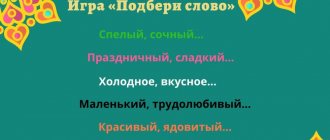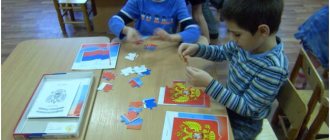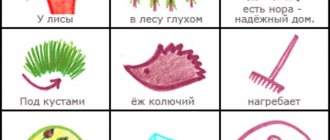MAGAZINE Preschooler.RF
Modeling as a means of developing coherent speech in preschool children“Teach a child some five words unknown to him - he will suffer in vain for a long time, but associate twenty such words with pictures, and he will learn them on the fly” K.D. Ushinsky
Mastery of the native language and speech development is one of the most important acquisitions of a child in preschool childhood and is considered in modern preschool education as the general basis for the upbringing and education of children. Timely and correct acquisition of speech by a child is the most important condition for full mental development. Without well-developed speech and the ability to think logically, there is no real communication, no true success in learning. L.S. Vygodsky wrote: “There is every factual theoretical basis to assert that not only the intellectual development of a child, but also the formation of character, emotions and personality as a whole is directly dependent on speech .
Unfortunately, parents in our time, due to difficult social conditions, due to employment or incompetence, allow the process of developing their child’s speech to take its course.
Preschool children have insufficiently developed skills in constructing coherent speech. Based on the results of diagnosing the level of development of this skill in children, the following disadvantages can be noted:
- short coherent statements
- are characterized by inconsistency, even if the child conveys the content of a familiar
text;
- consists of separate fragments that are logically not connected with each other
- the level of information content is very low.
In addition, most children actively share their impressions of the events they experienced, but are reluctant to take on the task of writing stories on a given topic. Basically, this happens not because the child’s knowledge on this issue is insufficient, but because he cannot formulate it into coherent speech statements. Today, there are many methods that can be used to regulate the process of development of coherent speech in children, one of them is visual modeling. Scientific research and practice confirm that visual models are the form of highlighting and designating relationships that is accessible to preschool children. Visual modeling makes it easier for children of primary preschool age to master coherent speech, increase memory, expand their understanding of the world around them, develop imagination and thinking, and the ability to retell fairy tales, relying on substitutes. In preschool age, thinking is visual-effective and visual-figurative, and not verbal-logical, therefore for children, it is much more useful to see reality than to hear a verbal story. Schemes, symbols, models are the conclusions, the result, the essence of the material that the child must learn.
The novelty lies in the introduction of visual models into the educational process, which makes it possible to more purposefully develop children’s coherent speech and enrich their active vocabulary.
Scientific philosophical justification indicates the study of the influence of training on the mental development of a child, where it occupies an important place in child psychology and preschool pedagogy. During an experimental examination of preschool children (P. Ya. Galperin, A. V. Zaporozhets, S. N. Karpova, D. B. Elkonin) it turned out that many knowledge that a child cannot learn on the basis of a verbal explanation from an adult or in a process organized by an adult actions with objects, he easily learns if this knowledge is given in the form of actions with models.
The continuity is that there is a connection between age groups and in each age group the material becomes more complex.
Analysis of diagnostic data showed that children find it difficult to formulate their statements logically. Realizing this allowed me to develop a series of activities and games for teaching fairy tales using the modeling method, taking into account the age characteristics of preschoolers.
There are 3 types of fairy tale modeling:
- serial
- motor
- temporal-spatial.
In middle and older groups, the temporal-spatial type of modeling fairy tales is mainly used. But before starting such a difficult work for children, I started with a simple - serial type of modeling fairy tales. I began to build my work by repeating cumulative fairy tales already familiar to children: “Turnip” , “Teremok” and “Kolobok” . The children remembered and named the characters in the fairy tale “Turnip” , clarified how many heroes there are in this fairy tale, what they are wearing, what color the clothes are. We looked at pictures from this fairy tale, laid out a mosaic of individual pieces of the fairy tale, and acted out the fairy tale using a tabletop theater. The fairy tale “Turnip” is small in content and all the children willingly participated in the dramatization of this fairy tale, trying very hard to imitate the movements and voices of the heroes of the fairy tale, which required intonation expressiveness from the children. In their free time, the children painted characters from the fairy tales “Turnip” , “Teremok” , and made buns. When all the preliminary work was done, I offered the children conditional substitutes for the characters in the fairy tale - these are models of heroes. With the help of models, the children composed fairy tales, sequentially, and told them. Next, I moved on to a more complex type of modeling - motor. The guys and I remembered familiar fairy tales: “The Pockmarked Hen” and “Zayushkina’s Hut . A lot of preliminary work was done on these fairy tales: illustrations were examined, the most interesting and most difficult to tell episodes of a particular fairy tale were played out. Children actively participated in the re-enactment of the fairy tale “Chicken - Ryaba” .
I used nursery rhymes - sayings:
The fox walked through the forest, the fox made songs, the fox tore the stripes, the fox weaved bast shoes - this is another saying.
And the fairy tale will go further.
Under the influence of properly organized educational work, everyday communication, games and special activities, some children moved on to more advanced forms of constructing coherent speech and mastering correct sound pronunciation. The children's speech became richer in content and acquired a more complex structure by the end of the school period. The vocabulary has increased significantly; children’s conversations often no longer refer to data, directly perceived circumstances, but to what was perceived earlier or told by parents and educators and other children. This expansion of speech communication led to a change in the structure of children's coherent speech. This change in the structure of speech is closely related to the emergence of reasoning, logical thinking. At the same time, in the speech of a child of primary preschool age, along with new features, the features of the previous stage of development are preserved. Despite the fact that his speech acquires greater coherence than that of a baby, it still often contains replacements of missing nouns with instructions like this, this, there, etc.
Gradually mastering all types of coherent utterances with the help of modeling, children learn to plan their speech. The result of systematic work on teaching children storytelling with the help of modeling is that by the end of the preparatory group the children composed detailed stories, retold literary works, composed their own, well mastered the construction of grammatical structures, and understood the meaning of verbs, categories of nouns and adjectives.
Thus, the sooner we teach children to tell and retell using the modeling method, the better we will prepare them for school, since coherent speech is an important indicator of a child’s mental abilities.
| Next > |
USING MODELING TECHNOLOGY IN THE DEVELOPMENT OF CONNECTED SPEECH OF PRESCHOOL CHILDREN
.
Evstafieva Lyubov Grigorievna
Senior teacher of the Department of “Preschool Education Methods” of the Institute for Retraining and Advanced Training of Directors and Specialists of Preschool Educational Organizations in Tashkent (93 386 70 62)
Abstract: The article talks about the use of visual modeling in working with preschoolers, the use of modeling in work on the development of coherent speech in preschool children.
Key words : Modeling the basis of education and training, symbolic analogy
Speech is the greatest wealth given to man. Mastery of the native language and speech development is one of the most important acquisitions of a child in preschool age and is considered in modern preschool education as the general basis for the upbringing and education of children.
In our dynamic age, the flow of various information received by humans has increased significantly. Accordingly, the processes of perceiving this information become more complicated.
One of the leading experts in the field of education of preschool children N.N. Podyakov rightly emphasizes that at the present stage it is necessary to give children the key to understanding reality, and not strive for an exhaustive amount of knowledge. In preschool pedagogy, a model can become a tool of cognition.
Modeling is an attempt to use visual, motor, and associative memory to solve cognitive problems.
The studies of many psychologists (L.A. Venger, D.B. Elkonin, etc.) note the accessibility of the modeling method to preschool children. It is determined by the fact that modeling is based on the principle of substitution - a real object can be replaced in children’s activities by another sign, object, or image.
The relevance of using modeling in work on the development of coherent speech in preschool children is that: ·
firstly, a preschool child is very flexible and easy to teach, but most preschool children are characterized by rapid fatigue and loss of interest in activities, which can be easily overcome by increasing interest through the use of visual modeling;
· secondly, the use of symbolic analogy facilitates and speeds up the process of memorizing and assimilating material, and also develops the skill of practical use of techniques for working with memory; ·
thirdly, using a graphic analogy, we teach children to highlight the main thing, systematize, analyze and synthesize the acquired knowledge.
Many preschool teaching methods are based on the use of visual models, for example, the method of teaching preschoolers to read and write (D.B. Elkonin, L.E. Zhurova) involves the construction and use of a visual model of the sound composition of a word.
In order to teach children to express their thoughts coherently, consistently, and grammatically correctly, and to talk about various events from the surrounding life, it is necessary to use original, creative methods. One of these techniques is the use of mnemonic techniques.
Mnemonics comes from the Greek word mnemonics.
Mnemonics is a system of various techniques that facilitate memorization and increase memory capacity by forming additional associations, organizing the educational process in the form of a game. The use of mnemonics is currently becoming relevant. The main “secret” of mnemonics is very simple and well known.
When a person connects several visual images in his imagination, the brain records this relationship. And later, when recalling one of the images of this association, the brain reproduces all previously connected images.
Mnemonics in pedagogy are called differently:
• sensory-graphic schemes,
• subject-schematic models,
• square blocks,
• collage,
• a scheme for composing a story.
A mnemonic table is a diagram that contains certain information.
Common tasks for all types of mnemonic tables:
• memory development (training in various memorization techniques);
• the ability to analyze, isolate parts, combine into pairs, groups, the whole, the ability to systematize;
• development of logic;
• development of imaginative thinking;
• the ability to think coherently, compose stories, recode information;
• solving didactic and educational problems;
• development of ingenuity;
• attention training;
• skill of correct graphic representation.
The mnemonic table produces a graphic or partially graphic image of fairy tale characters, natural phenomena, and some actions, i.e. you can draw what you see fit. But depict it in such a way that what is drawn is understandable to children.
In the older group, modeling is introduced, with the help of which the syllabic structure of a word is reproduced, which not only contributes to better assimilation of the content of the program, but also prepares the child to determine the sound structure of a word at the stage of learning sound-letter analysis.
Modeling meets all State requirements for the development of children of early and preschool age of the Republic of Uzbekistan. Modeling refers to methods of educational work with children to implement the State Curriculum “Ilk Kadam”: it is simplicity, specificity, accessibility and clarity.
Almost all preschool educational organizations in Uzbekistan introduce the study of foreign languages. In this case, mnemonics can also help. This method has recently been widely used and gives very good results in many preschool organizations.
Thus, the use of visual modeling techniques helps us use all types of memory: visual, auditory, motor, improves thinking and speech, makes children’s statements more logical and consistent, and supports the interest of preschool children in active speech activity.
Bibliography:
1. Sapogova E.E. Modeling as a stage in the development of sign-symbolic activity of preschool children. V.P. 5-6, 1999
2. Ushakova O.S., Strunina E.M. Development of speech and creativity in preschool children: Games, exercises, notes for children. – M.2003.
3. Ushakova O.S., A.G. Arushanova, A.I. Maksakov, E.M. Strunina. Speech development classes in kindergarten. – M.2003.
4. Krasilnikova L.V. Development of speech activity in children 6-7 years old. M. 2010.
5. Bolshova, T.V. We learn from a fairy tale. Development of thinking in preschoolers using mnemonics [Text] T.V. Bolshova / St. Petersburg, 2005 - 71 p.
6. St. Peushina A.M. Development of coherent speech in a preschooler. Reader on the theory and methods of speech development in preschool children - M. 1999.
7. Psychology edited by Nemov R.S. Volume 3 M., 1999
8. https://www.maam.ru/obrazovanie/mnemotehnika




